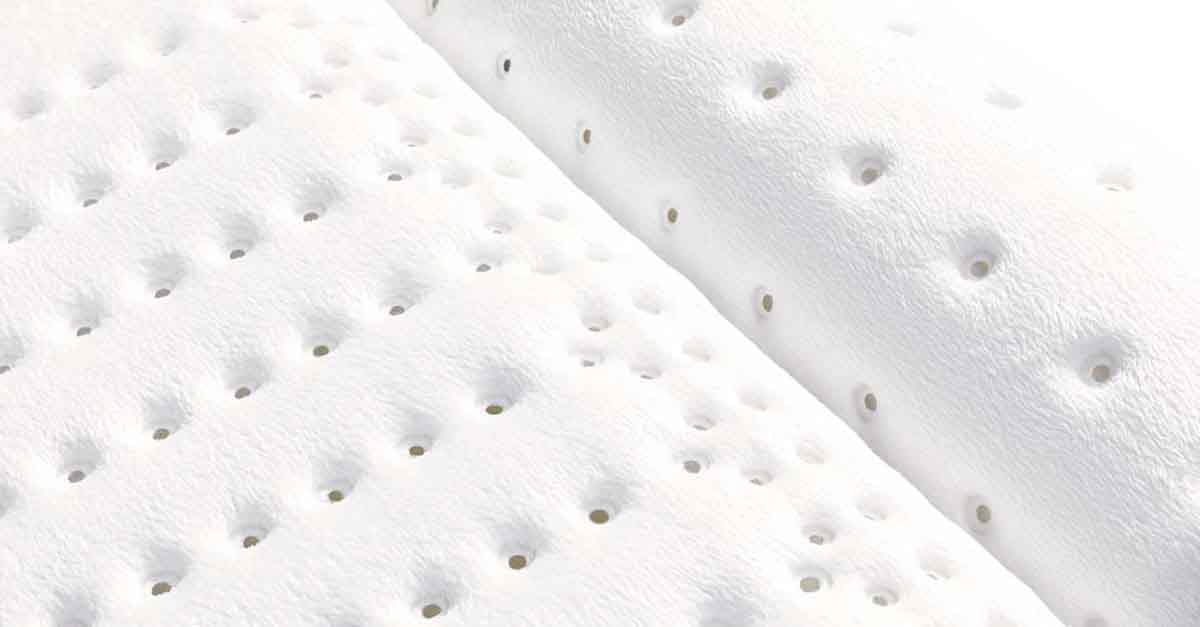
Electric blankets allow people who are afraid of the cold or want a cozy sleep environment to get a good night’s sleep. That’s why they have gradually become indispensable.
Electric blankets are common in European households, the current statistics show that more than 5 million electric blankets are sold on an annual basis in Europe. The global electric blanket market is expanding, a market analysis report estimated the value of the global electric blanket market would surge to US$1.2 billion by 2025.
Electric blankets are now widely available. For a company, understanding and anticipating consumer needs will not only build consumer confidence, but also help it to become a bedding industry leader. For a company that wishes to enter or is already engaged in the sleep industry, electric blankets are an effective and excellent entry product. They increase the bed temperature and rapidly boost the temperature of the extremities to promote sleepiness.
Wellcare compiled nearly 800 comments submitted by users between 2011 and 2019 to a popular German consumer review website on two electric blankets from the same brand but at different price levels. The first entered the market in 2017, and was a standard, single size electric blanket priced at around 20 euros. The second hit the market nearly a decade ago, and was a deluxe, single size electric blanket with a price tag of around 70 euros.
Analyzing these subjective comments about consumer preferences and complaints allows you to gain insights and develop innovative strategies that meet consumer needs.
The following are trends identified by Wellcare based on the issues that generated the most discussion in both positive and negative reviews.
Trend 1. The user experience is becoming more important to consumers
Many reviewers mentioned an excellent user experience for both the standard electric blanket and the deluxe electric blanket, with the proportion increasing with each passing year. Consumers generally said the electric blankets promoted relaxation and met their expectations, resulting in a satisfying user experience. This shows that consumers are willing to invest money and effort in the selection and purchase of electric blankets.
In fact, 86% of customers say post-purchase is the main factor affecting whether they’ll choose your service again. If consumers lose confidence in a product, this may increase hidden costs resulting from additional inventory, refunds, and returns. A product’s reputation may even be ruined by negative online reviews.
Trend 2. Consumers value safety and the timer function that automatically turns off
The standard model did not come with a timer function, so it does not switch off by itself, and there was a lot of discussion about this issue. Some consumers said they would like the electric blanket to automatically turn off to save energy, while others mentioned that their sleep was affected because they overheated in the middle of the night due to excessive heat It takes roughly 40 positive customer experience from the blanket. In 2017, 17.24 percent of comments mentioned these issues.
By 2019, the rate had fallen to 10.53 percent. It can be inferred from this decline that as customers became more familiar with the product, they gradually learned how to evaluate the quality-price ratio.

Percentage of comments mentioning the standard electric blanket’s lack of timer
Trend 3. Consumers value comfort
Electric blankets use wires to generate heat between the upper and lower layers and the insulating layer. It’s not comfortable to feel wires under your body. In 2017, 3.45 percent of comments mentioned that the wires of the standard blanket could be felt. This increased to 10.53 percent in 2019; many reviewers also said the wires were clearly visible. In earlier years, many consumers did not notice this problem, but they began taking note of it once they became more familiar with the product.
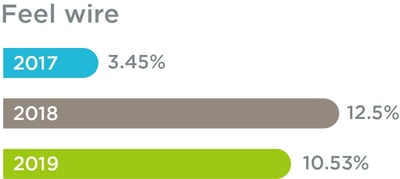
Percentage of negative comments mentioning that the standard electric blanket’s wires could be felt
Trend 4. Consumers value details
The growth in the number of comments mentioning the cost-performance ratio and discussing whether the price was reasonable shows that the cost-performance ratio is the main consideration when selecting an electric blanket. A considerably high proportion of comments in 2018 and 2019 on the standard model mentioned this issue.
The proportion was not high for the deluxe model, but negative comments about the expensive price and positive comments mentioning a reasonable cost-performance ratio show that price remains a major factor in the choice of electric blankets. We discovered that consumers have begun paying closer attention to details in recent years, and this holds true for both models.
1.Location of connection box’s plug is inconvenient, power cable is too short
A bedroom’s electrical outlets might not necessarily be next to the bed. Users may think that a blanket with a power cable that is too short and doesn't reach the outlet is unusable. Between 2011 and 2016, 6.45 percent of comments mentioned that the deluxe blanket’s power cable was too short. Between 2017 and 2019, the percentage was 7.55 percent.
Meanwhile, comments about the inconvenient location of the connection box included “poorly placed cable connection,” “connector on the cable is unfavorably positioned,” and “the connection is very bulky.” The resulting discomfort or proneness to loosening can affect sleep. Between 2011 and 2016, 23.66 percent of comments mentioned these issues, compared to 24.53 percent between 2017 and 2019. This was a popular topic of discussion both three years ago and in more recent years.
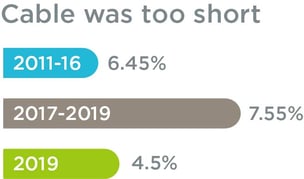

Percentage of negative comments mentioning the deluxe blanket’s short cable and inconvenient connection box location
2.Strap design issues
Elastic straps help to secure electric blankets to the mattress and prevent them from sliding around. However, poor elasticity of the straps may lead to negative comments. Although the standard model came with straps to affix it to the bed, one reviewer said, “The fixation is cumbersome and could be better.” In 2017, 2018, and 2019, 6.90 percent, 12.50 percent, and 10.53 percent, respectively, of the comments mentioned design problems of using straps that lacks elasticity, with 85 percent specifying that the strap design was poor.
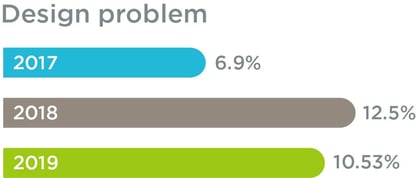
Percentage of negative comments mentioning the standard blanket’s design problems
Trend 5. Consumers value the quality of materials
Most people valued the cost-performance ratio when buying products, consumers purchasing the standard model who cares about quality, especially the quality of materials, is gradually increasing. In 2017, 10.09 percent of comments mentioned “good materials,” compared to 6.98 percent in 2019. There were no comments about poor materials in 2017, although 15.79 percent of comments referenced that in 2019.
This shows that consumers are attaching more and more importance to the quality of electric blanket materials. Electric blankets are placed under bed sheets and do not come into direct contact with bodies, but consumers care about the extra benefits resulting from the choice of materials. For example, wool is skin-friendly, breathable, and warm.
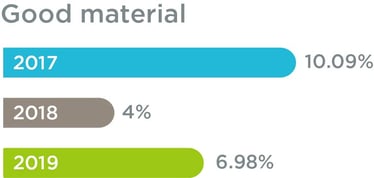
Percentage of positive comments mentioning the standard blanket’s good materials

Percentage of negative comments mentioning the standard blanket’s poor materials
Trend 6. Consumers value personal needs, the rise of niche markets
People who are familiar with electric blankets know that the heat may not reach some body parts if blanket that is too small. The deluxe blanket was 150x80 cm in size. This might be too small if placed on a big bed or used by someone with a larger stature.
Even though the size 150x80 cm can meet most customers' needs, some customers have different opinions. Comments included “would be better 20 cm longer, then the feet would also get warm” and “not so well-suited for our bed.” Between 2011 and 2016, 3.23 percent of comments mentioned the size issue, compared to 7.55 percent of reviews between 2017 and 2019.
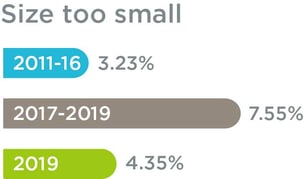
Percentage of negative comments mentioning the small size of the deluxe blanket
Trend 7. Consumers value after-sales service
Many consumers consider the product lifespan when selecting electric blankets. Numerous reviewers mentioned product malfunctions, highlighting the importance of after-sales service. Comments on the frequent malfunctioning and short lifespan of the deluxe blanket included “unfortunately, their durability was clearly limited” and “broke down after a short time.”
Between 2011 and 2016, 16.13 percent of comments mentioned these issues, compared to 22.64 percent between 2017 and 2019. Consumers expected the deluxe blanket would be durable. Although no product can last forever, reducing the failure rate is essential. Excellent after-sales service is also important in case there are consumer complaints, and the quality of the after-sales service has a significant influence on whether consumers will return.
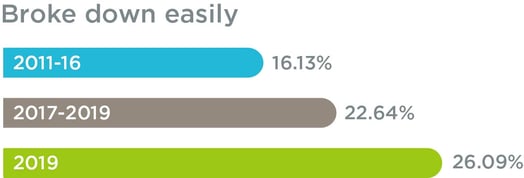
Percentage of negative comments regarding the durability of the deluxe blanket
Trend 8. Consumers believe a suitable temperature can create a good sleep environment
Everyone wants an electric blanket that can achieve the optimal temperature in a short amount of time, so that they won’t have to wait to lie down in a comfortable and warm bed. Apart from the heating speed, a pleasant, uniform, and consistent temperature is also very important.
The standard blanket received complaints about not being warm enough between 2017 and 2019 (13.79 percent, 18.75 percent, and 10.53 percent), with some comments saying it wasn’t hot enough even at Level 3, the highest setting.
Some even indicated that Level 1 produced no heat at all. Between 2011 and 2016, 5.38 percent of the comments about the deluxe blanket mentioned that the blanket was not warm enough. This increased to 11.32 percent in the period from 2017 to 2019. Comments included “not warm enough after an hour” and “the heating capacity does not correspond to the performance which is praised.”

Percentage of negative comments about the standard blanket’s warmth issues
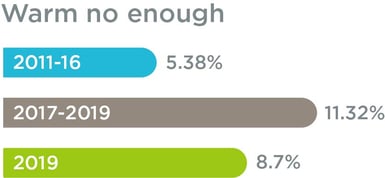
Percentage of negative comments about the deluxe blanket’s warmth issues
There were also comments about the inconsistent temperatures of both blankets. The even distribution of heating wire inside the electric blanket directly affects the comfort and user experiences.
Although everyone perceives heat and cold differently, an electric blanket that can improve on the aforementioned shortcoming will allow consumers to effortlessly create the Best Bed Climate. During times with fluctuating temperatures, using one can help people to sleep better.
The five major eras in the history of electric blankets
Electric blankets have evolved over the past 100 years. Wellcare has divided the evolution of electric blankets into five eras. We can see that each era experienced breakthroughs and growth in a virtuous cycle through technological advances; progress in manufacturing and development; and increased consumer knowledge. Electric blankets are continuously innovating and improving, and it is foreseeable that they will just keep getting better.
- First Era: Warmth
The first era started in approximately 1900. American doctor Sidney I. Russell invented the first electric blanket in 1912. The blankets back then were large and heavy, and were primarily used to keep patients warm.
- Second Era: Safety
The second era began in 1931 and ended in 1990. People start to care about safety of electric blankets, so new functions like thermostats, microprocessor-controlled signal wire, PTC wiring system, automatic switch systems, Super low EMF/No EMF detected features are invented
- Third Era: Comfort
The third era occurred between 1990 and 2000. During this time, the safety issues that had always existed in electric blankets were studied, such as extremely low frequency (ELF) electric and magnetic fields. The focus of this era was improving the comfort of electric blankets, and new standards for blanket materials were also developed.
- Fourth Era: Eco-Friendly
The fourth era took place between 2000 and 2015. During this time, the focus shifted to creating eco-friendly electric blankets as people became aware of their impact on the earth. PVC and PE heating wires were used to make electric blankets safer and give them a more reliable overheating protection system.
- Fifth Era: Sense
People began requiring electric blankets with a better sense, feel, and quality starting in 2016. This has continued until now. Consumers pay attention to details and want greater warmth and comfort. For example, a longtime issue with electric blankets is stifling or dry heat. In the past, people gradually got used to it so they accepted it. Consumers nowadays care about such details and will search for a solution that can create a better sleep environment and improve sleep quality.
The comments showed that consumers consider and value not only price, but also the tactile sensation and user experience. They care about and the details, number of knowledgeable users is increasing rapidly.
All problems, whether they are related to poor materials or quality, the uneven distribution of heat, or wires that can be felt through the blanket, need to be addressed from multiple angles, including technology, material choice, manufacturing processes, and craftsmanship. They will all need to be resolved together to improve the overall performance of electric blankets, and implementing these improvements will require a larger budget.
Wellcare cares about what consumers don’t say
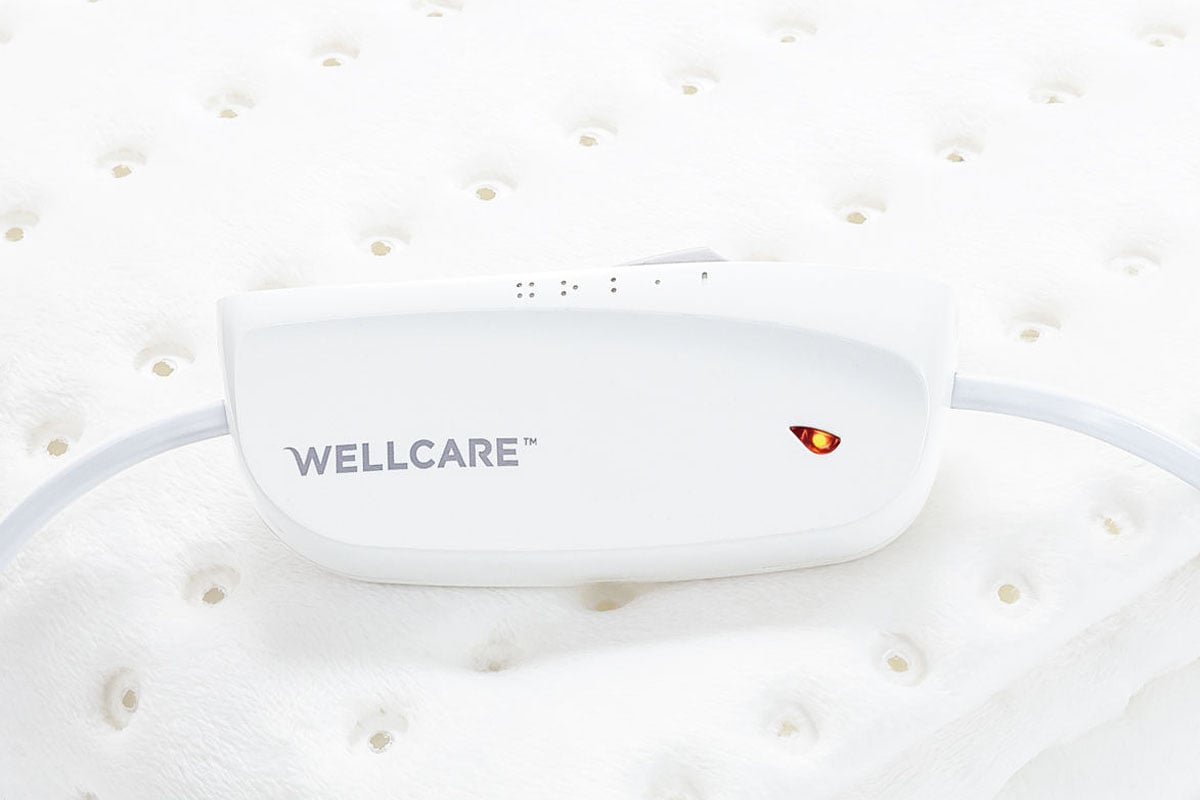
It has become normal for industries to pursue the maximization of their manufacturing scale and the minimization of costs. However, Wellcare is a company that is willing to invest more effort, rigorously select materials, maintain traditional craftsmanship, and integrate innovative technologies. We care about the invisible details and the unspoken voice of consumers.
Wellcare understands that consumer requirements are changing. Highly sensitive people will no longer settle for readily available electric blankets and will search for ones that are more suitable for their needs. This type of consumer pays careful attention to products, and is able to discern subtle quality differences between products. They are also interested in understanding the product design, design concepts, and manufacturing process.
Users are looking for products that are comfortable, relaxing, and safe while improving the quality of sleep. Wellcare believes that low-cost and low-quality products may not meet these requirements, and this is directly related to materials, design, and the manufacturing process. Let’s say a company lowers its standards or leaves out a necessary step. Even though it can still produce the product and the product looks no different and functions the same as before, those consumers who are highly perceptive and who care about quality will notice the differences.
Wellcare rigorously selects the materials it uses in its manufacturing process, and carefully and repeatedly checks every single step. We are willing to put more thought into our finished products. Our products go through a minimum of 250 processes and tests before they are completed, from materials, fabrics, and semi-finished products to finished products. We don’t mind that development times are extended and costs are increased, because we want to ensure every single product made by Wellcare will bring comfort and joy to the user.
Wellcare develops products using innovative designs, meticulously selected materials, attention to detail, and eco-friendly practices. We provide sleep-friendly solutions and share sleep knowledge, and support and assist our distributors to serve and satisfy consumers. If our ideology and methods resonate with you, please click on the below CTA, because you’re who we are looking for to help even more people to sleep better. Join us! (Recruiting distributors)


.png?width=512&name=united-kingdom%20(1).png)

